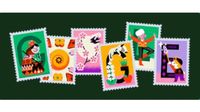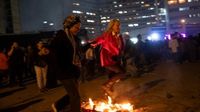As the world welcomes the first day of spring, the joyous celebration of Nowruz, the Persian New Year, shines brightly across many cultures. Nowruz marks the arrival of spring and symbolizes renewal, hope, and prosperity, dating back over 3,000 years.
Celebrated by approximately 300 million people, Nowruz begins at the precise moment of the spring equinox, which this year falls on March 20, 2025, at 5:01 AM EST (2:31 PM IST). Traditionally linked to ancient Persian and Zoroastrian customs, the event resonates with themes of rebirth and the triumph of light over darkness.
This year's celebration is underlined by a special Google Doodle, designed by guest artist Pendar Yousefi, that creatively pays homage to Nowruz and its rich cultural significance. The Doodle showcases vibrant spring motifs and embodies the essence of the festival that has remained a staple in Persian culture.
Central to the festivities is the Haft-Sin table, traditionally prepared with seven symbolic items starting with the Persian letter 'S.' These items include:
- Sabzeh (sprouts) - Symbol of rebirth
- Samanu (sweet pudding) - Represents strength
- Senjed (dried oleaster) - Signifies love
- Seer (garlic) - Stands for health
- Seeb (apple) - Symbol of beauty
- Serkeh (vinegar) - Represents patience
- Somaq (sumac berries) - Stands for a fresh start
Alongside the Haft-Sin table, families engage in a tradition known as Khaneh Tekani, or spring cleaning, to clear out negativity and make room for positive energies in the new year. This communal preparation heralds a significant start to the season.
Another lively aspect of the pre-Nowruz celebrations is Chaharshanbe Suri, the fire-jumping festival that takes place on the last Wednesday before Nowruz. Participants jump over bonfires, chanting, “Zardi-ye man az to, sorkhi-ye to az man,” which translates to, “Take my paleness, give me your warmth.” This ritual is steeped in history, symbolizing purification and the shedding of past difficulties.
The actual Nowruz festivities culminate in family gatherings, where traditional dishes such as Sabzi Polo Ba Mahi (herbed rice with fish) and Kuku Sabzi (herb omelet) are enjoyed. Families come together to share gifts, flowers, and well-wishes, reinforcing ties and unity.
The celebration extends for 13 days, concluding with Sizdah Bedar, a day intended for picnics and connecting with nature. On this day, typically, people release sprouts into rivers, symbolizing the washing away of bad luck and welcoming a year of good fortune.
Beyond Iran, Nowruz is recognized in various countries like Afghanistan, Azerbaijan, Turkey, and among the Parsi communities that stretch across the globe. This festival serves as a unifying thread connecting diverse ethnicities through shared themes of renewal and harmony.
Historically significant, Nowruz was recognized by UNESCO in 2010 as an Intangible Cultural Heritage, reflecting its importance in promoting peace and understanding among communities. The United Nations has even designated March 21 as International Nowruz Day.
In Iran, Nowruz celebrations constitute four public holidays, with it lasting about two weeks. Despite occasional attempts to suppress celebrations during significant political upheaval, the festival’s popularity remains undiminished.
Nowruz is not just a cultural event; it is an occasion for introspection, reflection, and reaffirming connections with loved ones. As families gather to celebrate traditions that have unfolded over millennia, the essence of Nowruz shines brightly, symbolizing hope, renewal, and the zest for life.
As 2025 brings fresh beginnings, it is a time for people around the world to express joy and goodwill, embodying the spirit of Nowruz. With its time-honored traditions illuminating paths to unity and beauty, the Persian New Year invites all to participate and celebrate the arrival of spring.




